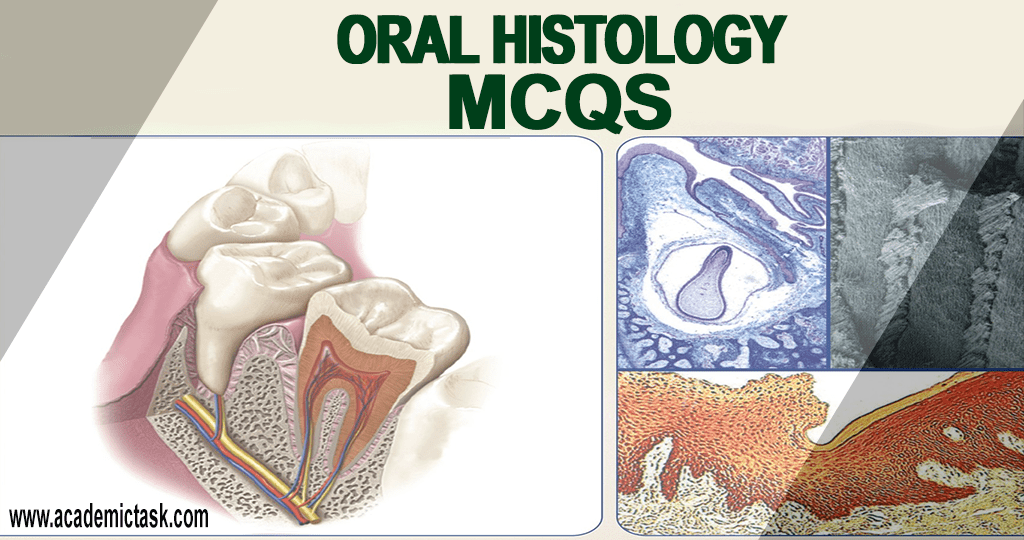
Histology is the science and study of tissues. Histo means a tissue, while Logy means science. By studying oral histology and embryology, you will gain a strong foundation in oral biology. The topic you study will focus on the development and structure of cells and tissues, the stages of tooth development and maturation. Different parts of a tissue, like cells, intercellular substance, tissue fluids, and the different parts of a human tooth, like enamel, dentin, dental pulp. Academic Task provides Oral Histology MCQs with answers. All these teeth histology MCQs are chosen from trusted and best reference books on oral histology. These histology MCQs are also helpful for the preparation of interviews, entrance examinations, other competitive examinations, and certifications for all Experienced, Freshers and Students. Also, check MCQs on Oral Pathology here.
1.Which of the following is true_____________?
A. All the bones of upper face develop by intra membranous ossification
B. Incus and malleus develops from mecketls cartilage
C. The third auditory ossicle or stapes develops from 2nd branchial arch
D. All of the above
2. Which of the following is not correct ?
A. In case of pituitary gigantis, all sinuses assume a larger volume than normal
B. In chronic infections, the pain may mimic neuralgia of dental origin
C. Malignant lesions of maxillary sinus produce their manifestations in maxillary teeth
D. None of the above
3. Which of the following is true?
A. Maxillary sinus communicates with environment through middle meatus and nasal vestibule
B. Maxillary sinus is four- sided pyramid
C. In most of the cases, the main ostium is present in posterior third of hiatus semilunar
D. All of the above
4. Which of the following is wrong?
A. The architecture of type I spongiosa is seen in mandible
B. Type II spongiosa is seen in maxilla
C. Condylar process & angle in mandible, and tuberosity in maxilla contain hemopoietic cellular marrow
D. Bundle bone contains a lesser amounts of calcium salts than other types of bony tissue
5. Which of the following is not true___________?
A. Alveolar bone proper surrounds the root and gives attachment to fibres of periodontal ligament
B. supporting alveolar bone surrounds the alveolar bone proper and supports the socket
C. The cortical plates are thinner in maxilla than in mandible
D. They are thickest in anterior portion of jaw
6. Which of the following is true___________?
A. Pulpal pressure is highest among body tissues
B. Majority of nerve that enter the pulp are non myelinated and are sympathetic in nature
C. Plexus of Rashkow or parietal layers of nerves is formed by network of peripheral axons located adjacent to cell rich zone
D. All of the above
7. Which of the following is correct ?
A. Parotid – stenson’s duct – pure serous
B. Submandibular – Wharton’s duct – mixed and predominantly serous
C. Sublingual gland – bartholin’s duct – mixed and predominantly mucous
D. All of the above
8. Which of the following is correct?
A. Roof of mandible contains thin, compact bone
B. Articular tubercle is composed of spongy bone covered with thin compact bone
C. Condyle contains red bone marrow
D. All of the above
9. The components of future TMJ shows development at_____________?
A. 6 weeks
B. 18 weeks
C. 10 weeks
D. 16 weeks
10. Which of the following is true?
A. Cutting cone or resorption tunnel is the area of resorption seen in alveolar bone
B. CAMP or cyclic adenosine monophosphate levels are increased on pressure side of bone and this results in bone resorption
C. Immature born / embryonic bone seen during fracture healing contains less calcified material and greater number of large osteocytes
D. All of the above
